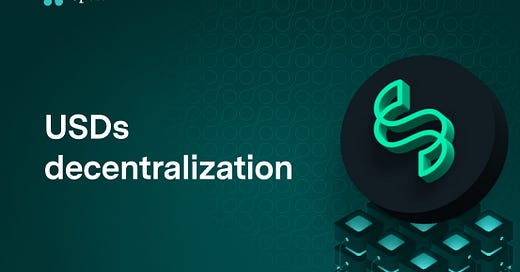USDs V2
We are kicking things off in the new year with an upgraded version of USDs. We are officially calling it USDs 2.0. Upgrading to USDs v2.0 is a step towards making the protocol more decentralized, transparent, secure, and scalable. With this upgrade, USDs is getting ready for full on-chain governance. In the new version, we have redesigned the configurational functions that control the protocol. Most of the functions that govern the protocol have been opened to the public, in some cases with some incentives for them to call the functions. In other cases, where some of the functions are owner-only, they have been designed in such a way that the control will be easily transferable to on-chain governance once established. All preset protocol parameters and configurations are upgradeable via the Sperax governance process.
Making redemptions more transparent
Now users can redeem their choice of collateral from any yield strategy, instead of relying on a preset default mechanism. Strategies are a set of smart contracts that control the depositing and withdrawal of collaterals from various other DeFi protocols like Aave, Compound, Curve, etc. The slippage that occurs is still transferred back to the redeemers. Since redeemers have a choice, they can calculate and manage their slippage. Withdrawing from single-sided strategies like Aave and Compound could have significantly less slippage when compared to withdrawing from any complex liquidity pool strategies like Curve.
Decentralizing the harvesting and distribution of Yield
Harvest functions in strategies transfer the yield generated from the various strategies back to the main USDs vault where they are further distributed back to USDs holders in the form of auto-yield. Calling those functions will be available to the public for a pre-configured incentive. Currently, the incentive is set at 1% of the total net yield collected. After the yield is harvested in various contracts, those yield tokens will be available for everyone to swap for USDs tokens without slippage. All USDs collected in the above step is split between revenue for the veSPA holders and USDs holders(Auto yield). After the yield is collected in the form of USDs, it will be released at a steady rate which can then be further distributed in the form of auto-yield based on certain pre-set parameters. Anyone would be able to call a function to distribute the auto-yield. Initially, the protocol would be set to distribute auto-yield when there is enough yield to satisfy a minimum APR of 3% and a maximum APR of 10% based on the amount of the USDs token balance.
Automating and decentralizing Mint and Redemption Fees
Fees will be calculated and configured based on the protocol’s collateral composition. Anyone would be able to call a function that updates the fee parameters. When a collateral exceeds the desired collateral composition, the minting fees for that particular collateral would increase, and its redemption fee would decrease. Similarly, when the amount of collateral in the protocol is less than the desired amount, the mint fee for that collateral would decrease, and the redemption fee would increase. Initially, all collaterals except for USDC will be set to have a desired collateral composition of 20%, and the base fee will be set to 0.05%. Any collateral having a composition of greater than 20%, e.g. LUSD will have a mint fee higher than the base fee. The exact logic will be provided in the docs. The applicable fee at any time can be queried via a view function in the contract.
Major security upgrades, code audits, and bug bounties to follow:
Previous versions of the contracts were audited when USDs was an algorithmic stablecoin. Since then, it has gone through a lot of changes. Old contracts were not verified publicly, limiting the transparency of USDs. With this upgrade, we want to push more on transparency and security. All the contracts have gone through an audit via Quantstamp. The final audit report has been published for everyone to see here. We will also verify and publish the contracts for everyone to review on Arbiscan. We believe in building for the community and with the community. With the above upgrades and open-sourced code base, USDs will be more scalable and easily contributable.
Some things that do not change but are worth highlighting would be the mint and redemption caps:
Mint and Redemption caps
While minting USDs, if the price of the collateral token is more than 1 USD, then USDs will treat the price of the collateral as 1 USD and will only mint 1 USDs per collateral token deposited. If the price of the collateral is less than 1 USD, then more units of the collateral will be required to mint a unit of USDs. In that case, minters would need to provide 1 USD worth of collateral to mint 1 USDs. If the price of any collateral drops below 0.97 cents, then users would not be able to use that collateral to mint USDs. While redeeming, a user will always receive one unit of any collateral token of choice for one unit of USDs.
Our 2024 roadmap article is coming soon…
About Us
Sperax manages two protocols: USDs, an auto-yield bearing stablecoin protocol, and Demeter, an open-access yield farming platform, on Arbitrum Network.
Read more at sperax.io and join the Sperax community!
X | Discord | Telegram| Telegram Korea| Substack




